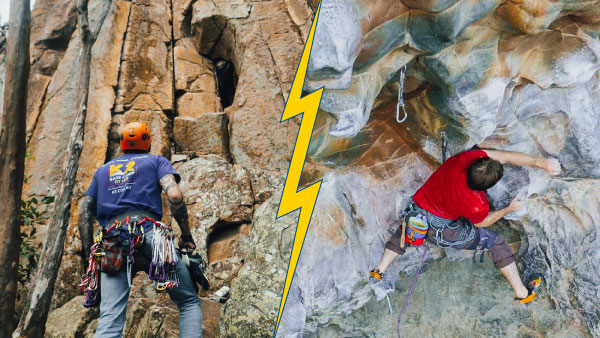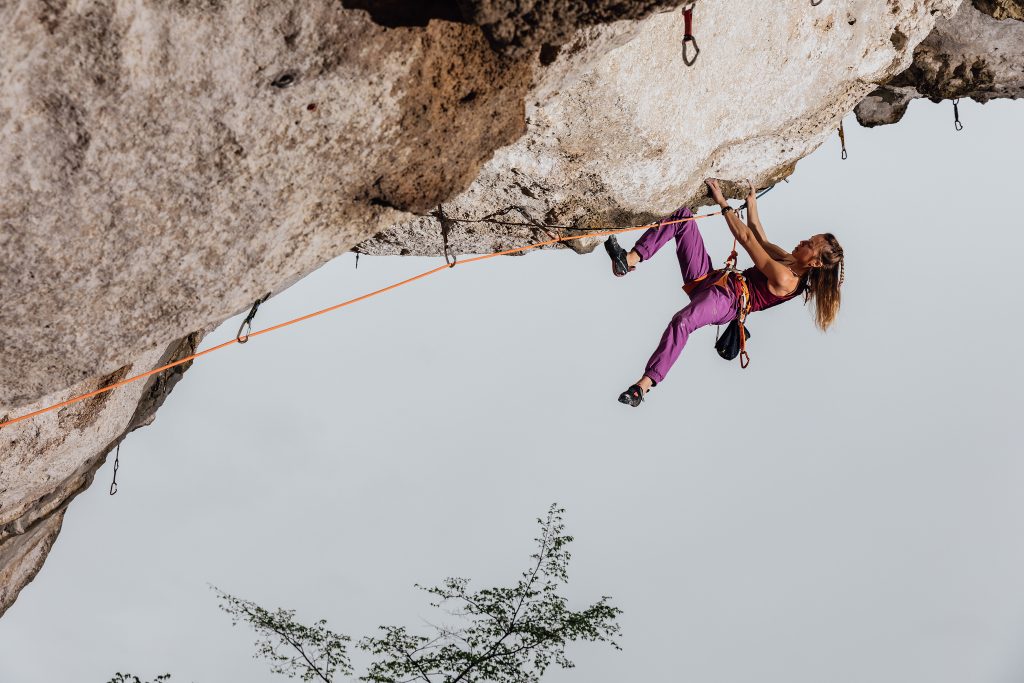
Trad Climbing vs Sport Climbing - Key Differences
In this article, we tackle Trad climbing vs Sport climbing. The old school vs the new school of free climbing. We’ll look at what’s what, before running through a quick comparative gear list, then wrapping it up with the pros and cons.
Free climbing and aid climbing were the original forms of climbing. Free climbing (not to be confused with free soloing, a dangerous discipline of climbing, where climbers climb without any form of gear or aid) is a form of climbing where equipment may be used, but only to protect against injury, not to assist with progress on the route. “Trad” as in Traditional climbing and sport climbing both belong under the umbrella of free climbing.
Before the 1980s there was no such thing as Traditional climbing, as the name suggests is traditionally how everyone used to free climb. Only after the invention of bolted climbing, by Alan Watts, did climbers need the labels of “trad” and “sport” to distinguish between the disciplines.
Trad Climbing at A Glance
Traditional climbing is a much more visceral adventure experience than sport. Trad is always done outdoors and requires you to place your own protection (pro) in the natural features of the rock. Experienced trad climbers command prestige and respect, due to the implied risks and responsibility of placing your own pro. Due to this, trad climbing is done at a slower, more intentional pace. A beginner trad climber will usually climb well below their sports grade as it is more technically challenging and endurance heavy.
Incorrect protection placement can lead to gear popping (a piece pulling out of its placement on the wall) or zippering out (when multiple pieces blow out at once) of the wall, leading to climbers falling further than intended or worse. Due to this trad climbers try to avoid falling too much on their gear placements. Fun fact: This is where the old adage “the leader never falls” originates.
Trad gear normally includes active protection and passive protection. Active pro involves spring-loaded devices called ‘cams’, whereas passive pro has no moving parts; relying on constrictions in the rock to hold them in place. On completion of the climb or pitch, you need to build an anchor to belay your partner up, as your partner ascends they remove the gear you placed.
Trad climbing is about a sense of adventure and maintaining composure despite the risks.

Sport Climbing at a glance
In the 80s, a revolution occurred where climbers began to forgo the heavy traditional gear. Climbers instead began to rely on bolts drilled directly into the rock, this was the birth of Sports climbing. Fun and dynamic, it can be done indoors or outdoors, Sports climbing quickly became the darling of the climbing world.
The use of in situ protection allowed climbers to shift focus from route finding and pro placement towards a greater focus on the athletic pursuit of a route. It’s allowed climbers to bypass the intentionally slow and calculated pace needed to place gear and lessen the burden of pros failing (though most climbers are well aware, bolts are not in anyway a fail-safe system). Less gear is required to partake in sport climbing, making it a more inclusive discipline, which has helped popularize the sport into the Olympic star we see today.
Sports climbing lead to the opening of dedicated climbing gyms in urban environments. This allowed climbers easy access to a space where they could train their bodies to move with more power and intention which allowed climbers to project* harder climbs.
Sport climbing is about movement on rock and about pushing personal athletic limits.

*Project is climbers' jargon. It means: putting time and effort into the process of climbing something that is at the absolute limit of your physical ability.
Comparative Trad vs Sport Gear List
Trad Gear List
Core:
- Rope
- Climbing Shoes
- Harness
- Helmet
- Chalk Bag
- Personal Anchor System
- First Aid Kit
Trad Rack
- Sling (Dyneema, Cordelette)
- Runner/Extender
- Alpine Draws
- Quick Draws
- Carabiners (HMS, D Shape)
- Nuts
- Cams
- Nut Tool
Highly Recommended
- Double/Triple Rack of cams
- Crack gloves/Climber Tape
- Climbing Brushes
Optional
- Hexes
- Set of micro cams
- Set of small brass nuts (RP’s)
- Belay Glasses
Sport Gear List
Core
- Rope
- Climbing Shoes
- Harness
- Helmet
- Chalk Bag
- Personal Anchor System
- First Aid Kit
- Quick Draws
- Rope: 60m for most cases/ 70m
- Belay Device
Highly Recommended
- Guide Book
- Extra bail carabiner
- Stick Clip
- Rope Tarp/ Bag
- Climbing Brushes
Optional
- Belay Glasses
- Panic Quick Draw
- Finger Tape
Trad Climbing Pros and Cons
Pros:
- Trad climbing is considered by some as true adventuring due to the high level of skill and self sufficiency needed
- More engaging and rewarding climbing experience
- Allows you to make your own route and is less likely to encounter others on the route
- Highly immersed in nature
- Potentional to develop a strong understanding of equipment
- Potentional to develop a higher understanding of route finding and other climbing techniques
- Bragging rights
Cons:
- Higher level of safety risk
- A larger toll on gear, with higher risk of gear loss
- Requires more technical and gear-related knowledge, that should always be taught by a professional or experienced trad climber
- More gear necessary than sport climbing, requiring you to carry more weight and outlay more upfront costs, then sports climbing
- Higher levels of planning and preparation necessary
- Less ability to project tricky sections as Trad climbers are careful not to fall
- Mostly done outdoors so the elements may vary drastically day to day
Sport Climbing Pros and Cons
Pros:
- Established routes to follow meaning less time route finding
- You carry much less gear, meaning less weight,allowing for faster climbing
- Easier entry for beginner climbers as it is more inclusive skill wise
- More budget friendly
- Often more social
- Can be done indoors or outdoors giving more variety and flexibility
- Allows climbers to project more on harder problems
Cons:
- You’re reliant on predetermined routes and bolts
- Popular routes can get very congested, meaning less time climbing overall
- Climbing on the same setups might make it less engaging after a while
- Relies on existing fixed gear that may not always be reliable or properly placed.
So there we have it Trad Climbing vs Sport Climbing. In reality, comparing the two is like comparing apples to oranges. They both have their strengths and weaknesses and the choice comes down to the individual climber and what they are looking to get out of climbing. Which one would you choose?
Disclaimer: Rock Climbing is a high-risk activity that can lead to serious injury. You should not undertake this activity without proper training or equipment.
